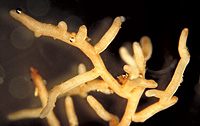
 |
– Enlarged view – |
| • references | |
| Ingleby K, Mason PA, Last FT, Fleming LV (1990) Identification of ectomycorrhizas. ITE Research Publication no. 5. HMSO, London. | |
| • length | |
| 0 mm | Lower value of unspecified range (could be µ-s.d., but not known) |
| 6 mm | Upper value of unspecified range (could be µ+s.d., but not known) |
| • ramification presence-type | |
| monopodial-pinnate | |
| • ramification orders | |
| 0 | Lower value of unspecified range (could be µ-s.d., but not known) |
| 1 | Upper value of unspecified range (could be µ+s.d., but not known) |
| • main axis diameter | |
| 0 mm | Lower value of unspecified range (could be µ-s.d., but not known) |
| 0.4 mm | Upper value of unspecified range (could be µ+s.d., but not known) |
| • rhizomorphs as stout, short, conical structures presence-abundance | |
| absent | |
| • rhizomorphs as short mycorrhiza-like outgrowths with blunt tips presence | |
| absent | |
| • rhizomorphs presence | |
| absent | |
| • shape | |
| straight | |
| or | bent |
| or | sinuous |
| • shape {of distal end} | |
| not inflated, cylindric | |
| • colour | |
| grey | |
| or | white |
| • very tip colour | |
| whitish | |
| • older parts colour | |
| brown | |
| • mantle cortical cells visibility | |
| not visible | |
| • mantle {distinct} surface visibility | |
| present | |
| • mantle transparency | |
| not transparent | |
| • mantle laticifers visibility | |
| absent | |
| • mantle dots presence-colour | |
| absent | |
| • mantle carbonizing presence | |
| absent | |
| • mantle surface {in general} habit | |
| shiny | |
| or | smooth |
| • emanating hyphae presence | |
| absent | |
| • presence | |
| absent | |
| • presence | |
| present | |
| • location | |
| inner mantle layer | |
| • cell diameter | |
| 3 µm | Lower value of unspecified range (could be µ-s.d., but not known) |
| 6 µm | Upper value of unspecified range (could be µ+s.d., but not known) |
| • matrix presence | |
| present | |
| • matrix location | |
| outer mantle layer {apart from tip} | |
| • organisation | |
| plectenchymatous | |
| • mantle type | |
| gelatinous matrix between the hyphae (type C) | |
| • matrix kind | |
| gelatinous | |
| • hyphal system kind | |
| forked | |
| and | with rather short, obtuse, even finger-like branches |
| • hyphae hyphal junctions angle {between} | |
| ca. 120° | |
| • septa thickness {relative to cell walls} | |
| as thick as walls | |
| • septa clamps presence | |
| absent | |
| • cell shape | |
| cylindric, not constricted at septa | |
| • cell diameter | |
| 2 µm | Minimum value |
| 3 µm | Lower value of unspecified range (could be µ-s.d., but not known) |
| 4 µm | Upper value of unspecified range (could be µ+s.d., but not known) |
| 5 µm | Maximum value |
| • cell wall surface habit | |
| smooth | |
| • drops of exuded pigment presence | |
| absent | |
| • organisation | |
| pseudoparenchymatous | |
| • hyphae arrangement | |
| plectenchymatous, without pattern | |
| • cell diameter | |
| 3 µm | Lower value of unspecified range (could be µ-s.d., but not known) |
| 10 µm | Upper value of unspecified range (could be µ+s.d., but not known) |
| • cell wall surface habit | |
| smooth | |
| • organisation | |
| plectenchymatous | |
| • septa clamps presence | |
| absent | |
| • cell diameter | |
| 2 µm | Lower value of unspecified range (could be µ-s.d., but not known) |
| 5 µm | Upper value of unspecified range (could be µ+s.d., but not known) |
| • mantle thickness {apart from tip} | |
| 15 µm | Lower value of unspecified range (could be µ-s.d., but not known) |
| 25 µm | Upper value of unspecified range (could be µ+s.d., but not known) |
| • clamps presence | |
| absent | |
| • clamps hole presence | |
| absent | |
| • reaction with toluidin blue presence | |
| present [strongly pink] | |
| • geographic occurrence continent | |
| Europe | |
| • plant family | |
| Betulaceae | |
| • plant genus | |
| Betula | |
| • plant habitat kind | |
| nursery | |
| or | forests, woods |
| • family | |
| Russulaceae | |
| • subgenus-section | |
| Lactarius sect. Russulares | |
| • fruitbodies growth habit | |
| epigeous | |
| or | pileate-lamellate |
| • public notes | |
| Mycorrhizal systems fairly short, with a frequent, sometimes pinnate, branching pattern; mycorrhizal ends white to smoky-grey when young, chaning to different shades of brown with age; mantle in toluidine blue strongly pink. | |